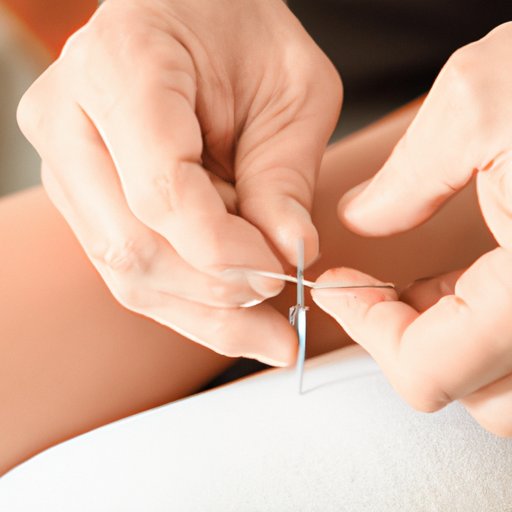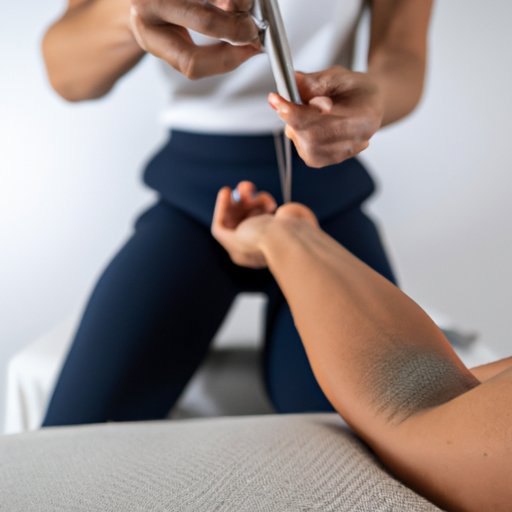
I. Introduction
Dry needling is a relatively new technique in the world of physical therapy and rehabilitation. This technique is gaining popularity because it is a non-invasive alternative to traditional methods of pain management and promises quick recovery. In this article, we will provide you with a comprehensive guide to dry needling in physical therapy to help you understand this technique and its benefits.
II. Understanding the Benefits of Dry Needling in Physical Therapy
Dry needling is a technique used by physical therapists in which they insert thin needles into specific trigger points in the muscles. This technique is used to relieve pain, increase range of motion and flexibility. Dry needling is different from traditional acupuncture, which is an ancient Chinese practice that involves inserting needles into specific points on the body to restore balance to the body’s energy.
The benefits of dry needling in physical therapy are mainly centered around pain relief. When the needles are inserted into the trigger points of the muscles, it enhances blood flow in the area and stimulates the release of endorphins, which are natural painkillers in the body. Endorphins are responsible for reducing pain levels and inducing a feeling of relaxation, which can help patients with chronic pain conditions.
Dry needling is also effective in increasing the range of motion in the muscles. By releasing tension and tightness in the muscles, the technique increases flexibility, range of motion, and muscle strength. It is an effective treatment option for conditions like muscle strains, tennis elbow, back pain, headaches, and joint pain.
III. Complete Guide to Dry Needling Therapy: Every Thing You Need to Know
The process of dry needling involves the physical therapist inserting a thin needle into specific trigger points in the muscles for the purpose of releasing tension, improving range of motion and alleviating pain. The technique typically takes less than 30 minutes and is performed in the therapist’s office. Before the therapy, the physical therapist identifies the problematic trigger points and sanitizes the area. The needle insertion is hardly felt or causes any discomfort, only a slight tingling sensation or a muscle twitch.
During the session, the therapist manipulates the needle according to the type of muscle, the trigger point, and the level of stimulation required. Following the therapy, patients may feel mild soreness or bruises, which is normal and dissipates in a day or two.
IV. Dry Needling: The Newest Technique for Physical Therapy Pain Management
Dry needling is different from other physical therapy techniques like massage, stretching, and chiropractic adjustments because it is a technique that targets a specific problem area, whereas other techniques are more general in approach. Dry needling technique can complement physical therapy sessions or can be implemented separately, depending on the severity of the condition and consultation provided by the therapist.
Dry needling is an effective technique used for pain management that is less invasive than traditional medical procedures and drugs. This technique can relieve symptoms within one or two sessions, making it an excellent alternative treatment option. In comparison with other pain management techniques, dry needling reduces the need for medication and shows results quicker.
V. Differentiating Dry Needling from Acupuncture in Physical Therapy
Dry needling and acupuncture are often confused as the same technique, but there are significant differences between these two techniques. Acupuncture is based on traditional Chinese medicine, and its goal is to restore energy flow in the regions of the body through the strategic insertion of needles. Dry needling focuses on finding trigger points where the muscle isn’t working adequately or actively engaging, causing pain in the region. Through manipulation of these trigger points, the goal of dry needling is to reduce pain and improve mobility and flexibility in the individual.
Dry needling is used in physical therapy to complement physiotherapy sessions or as an alternative to traditional treatment of injuries like sprains, strains, tendonitis, and chronic conditions. In contrast, acupuncture is used for a variety of health and wellness purposes like weight loss, addiction, and neuropathy.

VI. Expert Insights into the History of Dry Needling in Physical Therapy
The origin of dry needling can be traced back to the early 18th century when local Turkish tribes first used needles for pain relief. In the 1930s, American physician Janet Travell identified that trigger points caused referred pain and that relieving tension and tightness in those trigger points could alleviate pain. Later, Physical therapists Janet Travell and David G. Simons further developed dry needling therapy for treating myofascial pain in the 1970s.
In recent years, dry needling has gained global recognition as an effective treatment option, and it is now used worldwide for treating a variety of injuries and conditions.
VII. What Makes Dry Needling an Effective Treatment Option in Physical Therapy
The science supporting dry needling therapy speaks for its effectiveness. Studies have shown that dry needling in physical therapy has a competitive edge over placebo and traditional therapy techniques. Research indicates that the technique enhances blood flow in the affected region, reduces inflammation, improves range of motion, increases flexibility, restores muscle function, and decreases pain levels.
Dry needling stimulates the body’s natural healing response by inducing the release of endorphins and other hormones that reduce pain, producing a relaxing effect on the body, and bringing about an overall sense of well-being.
VIII. Dry Needling: The How-To Guide for Physical Therapy Practitioners
Becoming a dry needling practitioner requires specific qualifications that vary according to the state or local government policies and regulations. Typically, physical therapists are the ones who offer dry needling therapy. Still, other healthcare professionals like medical doctors, chiropractors, and certified personal trainers can become dry needling practitioners by completing the requisite certification and training at internationally recognized institutions.
Dry needling is a technique that requires a high level of technical skills and delicacy to minimize the risk of complications, and it should only be undertaken by a certified and licensed healthcare professional.
IX. Conclusion
Dry needling is a rapidly growing technique for physical therapy pain management. This technique is a non-invasive alternative to traditional methods that have varying success rates. By targeting specific trigger points, dry needling can alleviate pain, improve mobility, increase blood flow, and enhance muscle function. Given the many benefits of dry needling therapy, it is an excellent alternative in the treatment of injuries and chronic pain conditions.





